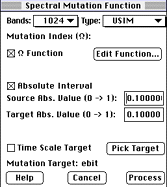| Mutation: |
|
| Originally coined by David Rosenboom, the term mutation is applied by Larry Polansky to the process whereby some parameter (sign, magnitude or both) of one sound file (source) is 'mapped' onto that of another sound file (target). The mutation program uses the intervalic distance between FFT frames to gererate the contour or sign. A mutation function is applied to either uniformly or irregularly extrapolate sign, magnitude or both and paste it onto that of the target. For this reason the source and target must be identical in length (achieved in SoundHack by either an automatic truncation of the target or, if time scaling is selected, a time stretching/contracting of the target to match the length of the source). Once the mutation process is finished a file is created which contains the mutant soundfile which will maintain some characteristics of the source and the target depending upon specifications made in the mutation window. |

|
|
Source: the first sound loaded into the mutation function is termed the source. During mutation, parameters (magnitude, sign or both) of the source sound are calculated and 'pasted' onto the target soundfile.
|
Target: the sound file in mutation onto which the parameters of the source file are pasted. |